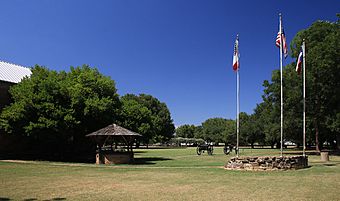Fort Belknap (Texas) facts for kids
|
Fort Belknap
|
|

Flags and artillery at Fort Belknap.
|
|
| Nearest city | Newcastle, Texas |
|---|---|
| Area | 15.3 acres (6.2 ha) |
| Built | June 24, 1851 |
| NRHP reference No. | 66000824 |
Quick facts for kids Significant dates |
|
| Added to NRHP | October 15, 1966 |
| Designated NHL | December 19, 1960 |
Fort Belknap, found near Newcastle, Texas, was a very important military fort. It was built in November 1851 by General William G. Belknap. The fort's main job was to protect the people living on the Texas frontier. It helped keep them safe from raids by the Kiowa and Comanche tribes.
This fort was the northernmost one in a long line of forts. These forts stretched from the Rio Grande river all the way to the Red River. Fort Belknap was more like a main base than a heavily protected castle. It became the center of many roads, including the famous Butterfield Overland Mail route. In 1960, Fort Belknap was named a National Historic Landmark. This honor recognized its big role in making the Texas frontier safe in the 1850s and 1860s.
Contents
Why Was the Fort Built?
Fort Belknap was part of a larger system of frontier forts. These forts were like a defense line for Texas. Other forts in this system included Griffin, Concho, and Richardson. There were also smaller stations between the main forts. These helped soldiers travel and communicate.
Important People and Discoveries
Some famous officers worked at Fort Belknap. These included Captain Randolph B. Marcy and Lieutenant George B. McClellan. They worked together to explore the Canadian River. They also found where the Red River begins. In 1858, a group of soldiers called the Second Cavalry was based here. They were led by Major George H. Thomas.
What Happened to the Fort?
Before the American Civil War started, the fort was left empty. This happened for a few reasons. One reason was that federal troops were moving north. Another big reason was that the fort often didn't have enough water.
When the fort was empty, Native American groups sometimes raided the Texas frontier. This caused many people to leave their homes. Families who stayed in Young County often hid in the empty buildings of Fort Belknap. They even used the old buildings for shelter during snowstorms.
The fort was briefly used again in 1867. But after that, it was left empty for good.
Fort Belknap Today
Over time, people took parts of the fort to use as building materials. By 1936, only the magazine (where ammunition was stored) and part of the cornhouse were left.
Later, starting with the Texas Centennial celebration, parts of the fort were rebuilt. They were put back mostly on their original foundations. In 2019, the fort began a new renovation project. This project updated the museum inside the commissary building. It also built a new support structure for a historic grape arbor. This arbor has the largest known mustang (muscadine) grape vine!
Today, the fort is also home to the Fort Belknap Archives. This archive keeps important historical records from North Texas.
Gallery








